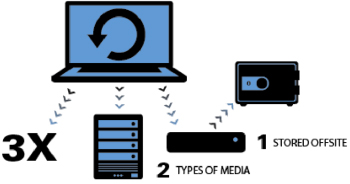3-2-1 Backup
How to Prepare for Data Loss
Retaining multiple, easily accessed physical copies of business data, on disks that the business possesses and knows the location of, helps recover quickly from data theft or loss.
CF Tech recommends the 3-2-1 backup rule to protect data. Hard disk backup is a key component of this system, utilizing disk enclosures to allow for expandable disk space and multiple backup copies.
Make Three Copies of the Data
Copy the same data files to different disks. This way, should one disk fail, it won’t take the only copy of that file along with it. Maintaining at least three copies of data may seem like it increases cost–in the form of purchasing more hard disks or cloud storage–and require more effort to keep everything organized—but the payoff is priceless.
The 3-2-1 Backup Rule
The idea behind this is fairly simple:
- Make three copies of data.
- Using two different types of media.
- Keep one copy at a separate location.
This diagram helps illustrate this concept:
Using Two Different Types of Media
“Media” means hard disks, CDs, tapes, thumb drives, DVDs, Blu-ray disks, etc. The idea with using different types of storage for extra copies is to protect against different types of technology failures, obsolescence, or environmental hazards. Note that it’s a good idea to test these forms of backup occasionally since technologies that seem like they’re permanent are really not (CDs and DVDs, for example, lose their ability to maintain data after a few years).
Keep One Data Copy at a Different Location
Maintain one copy of the business’s data away from the location where the primary backups are stored. This might mean keeping a copy with an IT consultant, taking one to a business owner/manager’s home, keeping it in a bank safe deposit box, or with a trusted family member. The idea is to spread out the risk of losing all backups. In this case, using a cloud service as an offsite backup may be a good choice, too.

Developing a Backup System
- Create a backup routine – the easier, the better. This involves identifying where and how data is created, minimizing employee downtime, determining storage needs, and recommending devices to accomplish backups.
- Put someone in charge – and hold them accountable. Often it’s preferable for the IT consultant to manage the backup process for a company, or at least to train people who perform the backups to make sure they are done regularly and correctly.
- Take a backup copy offsite – somewhere that is safe from disasters and theft. Storing them with an IT consultant is a good choice, and allows the consultant an opportunity to verify the disks and the backups stored there, as well. Safe-deposit boxes or a safe at a trusted employee’s home or other common choices to store the offsite backup.
- Validate backups regularly – pull the copies from storage (even the offsite ones) once a month or so and use them to make sure the data is safe and the disks are still operable.